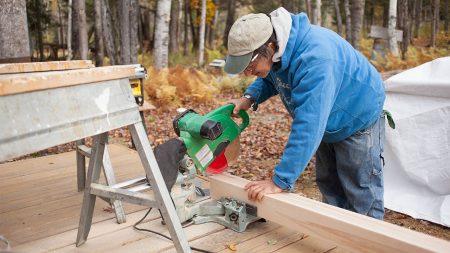Key takeaways
- For those wanting to grow older in their own homes, HELOCs (home equity lines of credit), home improvement loans and home equity loans may be a good way to finance the necessary renovations.
- If you’re moving in with a loved one, consider a personal loan or low-interest credit card to finance accessibility renovations and aids.
- FHA Loans, like Title 1 Property Improvement Loans and 203(k) loans, are often less expensive than other loans and have lower credit minimums.
Staying in your own home as you grow older offers many benefits. For most, it means a stronger sense of privacy, comfort and independence. It may also be cheaper than the cost of an assisted living facility, especially if your mortgage is paid off or if you have low monthly payments.
To safely age in place, you may need to make structural changes to your home. It’s best to begin planning these renovations early because the costs can be high. Still, these modification expenses can be more cost-effective than moving for some homeowners. You can also undertake many low-cost changes — like installing hold bars or adjusting lighting — that can make your home work for you longer as you age.
How to finance home renovations for accessibility
There are modifications you can make to your home to improve your quality of life as you age. Some can be as simple as installing sensor lighting around the house or replacing doorknobs with lever handles. Others, like installing a walk-in tub, may require professional help and come with a higher cost.
The renovations you make to your home will depend on your needs as you age, but there are a few common changes that may benefit many aging families. For instance, according to the National Association of Home Builders, 93 percent of remodelers in 2023 installed a grab bar. This can cost anywhere from $80 to $600, based on data from HomeAdvisor, and is relatively low cost compared to other projects.
That said, if you aren’t yet at retirement age, you may have an easier time planning ahead than trying to make changes when they are needed. Your peak earning years will likely be in your mid-30s through mid-50s, according to the Bureau of Labor Statistics. If you’re in that sweet spot, your credit score may be the highest it’s ever been, and you also may have significant equity in your home. If that’s the case, and you need help financing aging-in-place renovations, your two best options are home improvement loans and home equity loans.
Home improvement loans
Home improvement loans are personal loans taken out specifically for funding home renovations. They work best for short-term expenses and small amounts you know you can repay quickly because repayment periods are usually anywhere from one to 10 years.
These loans are typically unsecured, meaning they require no collateral. Approval relies on your credit score, credit history and income. You won’t have to tap into your home’s equity or put your home at risk, but you may face higher interest rates than those of home equity products.
Home equity loans and HELOCs
For larger, one-time expenses, turn to a home equity loan. These are useful when you need to tackle a big project, like making a bathroom wheelchair accessible or lowering your light switches, and are received as a lump sum. A HELOC allows you to draw from your line and pay it back as needed, which makes it a good option if you plan on tackling multiple smaller projects over a few years.
Home equity loans and HELOCs usually come with repayment periods of anywhere from five to 30 years. Since these loans are secured by your home, the interest rates are often lower than those of home improvement or personal loans. However, you will be using your home as collateral, which is a risk that could lead to foreclosure if you default.
Is a home improvement loan for senior citizens right for me?
The answer truly depends on what stage of life you are in and if you’re making improvements for yourself or an aging relative.
“Factor in prices for the renovations and get multiple quotes to make sure you are competitively pricing what you need,” says Steve Oniya, the director of OM Investments. “Talk to a financial professional to make sure you are also factoring in your savings, investments, and refinance options, among others, to find an efficient plan that meets your needs.”
Before you start planning any renovations or applying for loans, determine what type of funding you need and how your phase of life is reflected in your budget.
I’m still employed and haven’t retired yet
Best for you: Home improvement loan or home equity loan or HELOC.
Bankrate’s 2024 Retirement Savings Survey found that more than half (57 percent) of Americans working full-time, part-time or who are temporarily unemployed feel behind on their retirement savings.
Even though you may still be employed, if you’re contemplating aging in place and are reaching retirement, it’s a good idea to start planning. If you’re a homeowner, it can be easier on your budget to spread needed renovations over time. But depending on your age and retirement timeline, you might need to do several renovations at once to ensure that your property is ready.
Bankrate tip
You can integrate aging in place into other home improvement projects rather than doing them on a one-off basis.
I’m retired and on a fixed income
Best for you: Home equity loan or HELOC, government assistance or reverse mortgage.
If you’re like many retirees, Social Security might be your only source of steady income. Though this could make it difficult to fund your necessary accessibility improvements, finding funding is not impossible.
Your best option may be to utilize the equity you’ve built up in your property or consider a reverse mortgage, also called a home equity conversion mortgage. A reverse mortgage is a type of loan that gives you money from your home equity in either a lump sum or regular monthly payments. Repayment is due when the borrower passes away, sells the home or permanently moves out.
You may also consider an FHA-backed improvement loan, like a Title 1 Property Improvement Loan or a 203(k) loan. Because the federal government insures each loan, you are more likely get a lower rate than on other improvement or personal loans.
Another option is to apply for a government or state grant. Some agencies, such as the U.S. Department of Housing and Urban Development, offer home improvement grants for seniors. You will need to meet certain income and age requirements to be eligible. This makes them a bit more restrictive than other sources of financing. That said, it’s still worth a shot, as this money doesn’t have to be repaid.
I’m moving in with a family member
Best for you: Proceeds from your home sale, personal loan or low-interest credit card.
Best for your loved one: Home equity loan or HELOC.
Moving in with a family member or loved one may mean you have fewer options for customizing your living space. Talk with your loved one about potential renovations to make the property safer and more accessible.
Naturally, you’ll want to help your loved one pay for these renovations or cover them in full. If you’re selling your home before moving, the sale proceeds can go toward renovation costs. If you’re not selling a property, you may want to compare personal loan rates or apply for a low-interest credit card to cover the costs.
If an aging loved one is moving into your existing home, carefully consider the space in which they’ll live. If you don’t have a dedicated room for them to stay in, you might consider adding a mother-in-law suite or accessory dwelling unit on the property if your zoning laws allow it.
If you do have an available room, make an effort to improve its accessibility before your loved one moves in. The small changes above are a great place to start, as are updates to the bathroom they will use.
A home equity loan can help you cover the cost of immediately needed improvements and any other improvements your loved ones may require as they age. You may also consider a home equity line of credit, depending on your financial situation.
How to qualify for a home improvement loan as a senior
The first step is to research and find out what programs are available in your area. Because many programs are sponsored by either state or local governments or federal agencies such as the USDA, you can start by contacting your state’s Department of Housing and Urban Development to find out what programs are available. Requirements vary by program.
Private lenders also offer home improvement loans, though they aren’t designed specifically for seniors. For most, you will need:
- A credit score in the 600s or higher.
- A steady source of income.
- A debt-to-income ratio under 36 percent.
If you want to qualify for a home equity loan or HELOC, you’ll commonly find these requirements:
- At least 20 percent equity in your home.
- A credit score of 620 or higher.
- A debt-to-income ratio of 43 percent or less.
- A steady source of income.
No matter which type of loan you choose, it’s a good idea to shop around and find a program offering terms that make the most sense for you and your financial picture and needs.
Bottom line
While aging in place may require some home projects and financial planning, it may be a more cost-effective option for many people. According to research from the Delaware Journal of Public Health, even though home health costs are on the rise, they may still be more achievable than the expense of a live-in facility. 2024 data from the care consulting service A Place for Mom put the average median monthly cost for assisted living at $4,995 per month — an expense that may be out of reach for many seniors.
Assess your financial situation, mortgage balance and health needs early and often. You may find that strategic aging-in-place renovations made over time are the best choice for your financial future. But even if you’re entering retirement or have been on a fixed income for a while, there may still be options that keep aging in place accessible and affordable.
Read the full article here









